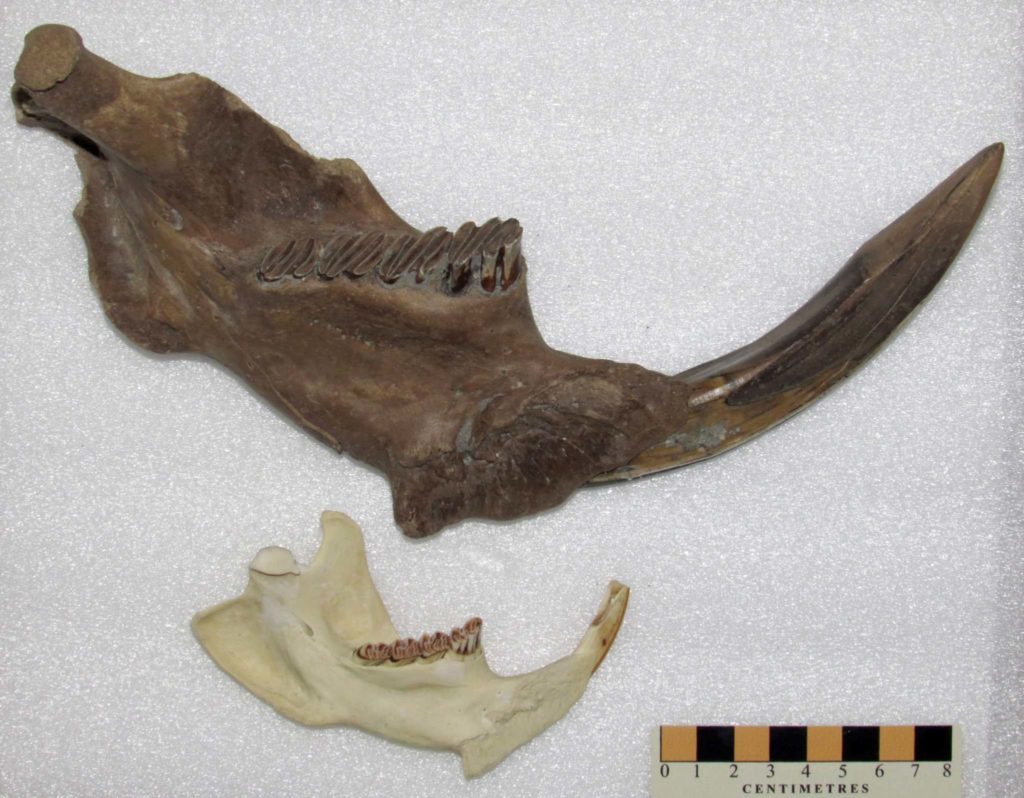@WFS,World Fossil Society,Riffin T Sajeev,Russel T Sajeev
Part of the skull of a prehistoric giant beaver — which rivalled the modern bear in size — has been found in a gravel pit in southeastern Manitoba.
The jaw bone, including a long front incisor and the back teeth in near-perfect condition, was discovered in a quarry south of Steinbach.

Dr. Randy Mooi / Manitoba Museum
– giant beaver jaw (Castoroides) compared to a modern beaver (Castor canadensis).Part of the skull of a giant beaver has turned up in southeastern Manitoba. The beaver, which was as large as our bears today, is estimated by Manitoba Museum paleontologist Graham Young to be from 50,000 years ago during a thawing period of the Ice Age. It’s the first such fossil found in Manitoba and only the fourth occurrence of a giant beaver fossil in Canada.
The giant beaver fossil is the first of its kind found in Manitoba — and only the fourth in Canada — even though it has long been believed to have existed in the province. There is a replica giant beaver skull on display at Oak Hammock Marsh.
The giant beaver species became extinct more than 10,000 years ago.
Graham Young, the curator of paleontology at the Manitoba Museum, said people often telephone the Winnipeg institution with what they think is an important find, but when a staff take a look, it usually turns out to not be the case.
“This fellow just walked in around lunch time and said, I’ve got these things, are you interested in seeing them? He thought maybe it was a pig’s jaw because the front tooth is like a tusk,” said Young.
Instead, it’s one of the best paleontological finds in Manitoba in recent years. The jaw bone has not yet been radiocarbon dated — it’s in a lengthy line behind numerous other fossils found in the province — but wood in the vicinity has been dated to 44,000 years ago.
“This is an amazing piece, it really is,” said Young. “With so many bones, you can’t tell what it is right away. With this giant beaver jaw, there was no question what it was immediately.”
Not only is the jaw intact, but a dentist would give its teeth a gold star: the front tooth is almost 12 centimetres long.
“There’s nothing more diagnostic than finding the jaw. The big front tooth is like a chisel on these giant beavers,” Young said.
The man who brought in the fossil also donated an ancient bison vertebrae and a long, curved length of bone believed to be a rib from either a mammoth or mastodon.
(It could be a mastodon because a tree radiocarbon dated in the area was black spruce, Young said, and mastodon used to feast on black spruce sprigs. A mastodon tooth has also been found in southern Manitoba, near Blumenort.)
The donor has requested anonymity, and not to reveal the exact location the beaver fossil was found.
“One thing to emphasize is there’s a heck of a lot of gravel out there and it’s rare to find anything at all. To find bone, it’s a real needle in a haystack,” said Young.
The period of the giant beaver was during the Ice Age, but the fossil’s time would have likely been during an interval when the ice sheet retreated to the north somewhat before advancing again south.
The tail of a giant beaver was skinny, not flat like the modern beaver, and grew to up to 2 1/2 metres long. It’s been debated whether the giants were lodge-builders or made their homes by burrowing into the ground. Its front teeth are strong and long but shaped differently than today’s rodent, so they didn’t eat bark, Young said.
It’s believed the giant beaver wasn’t as prevalent as its family members are now in Canada.
The donated fossil jaw is in such good shape, the animal likely died near where it was found, Young said. Fossils are sometimes transported long distances by various natural forces.
Previous giant beaver fossils in Canada have been found near Old Crow in the Yukon, in New Brunswick and in the Don Valley area of Toronto.
The fossil at the Manitoba Museum is now undergoing a long, slow drying process in controlled-climate conditions that will take months, in order to reduce the chances of cracking.
“The pieces we got have probably been sitting below the water table for probably over 40,000 years and are incredibly saturated,” Young said.
Young believes the giant beaver went extinct around 11,000 years ago, along with about 25 other large animals due to the arrival of people in North America and the animals being stressed by climate change.
He hopes to eventually put the jaw on display in an exhibit of fossils found in southeast Manitoba.
Source: Article by Bill Redekop, winnipeg free press
@WFS,World Fossil Society,Riffin T Sajeev,Russel T Sajeev



 November 11th, 2017
November 11th, 2017  Riffin
Riffin  Posted in
Posted in  Tags:
Tags: 